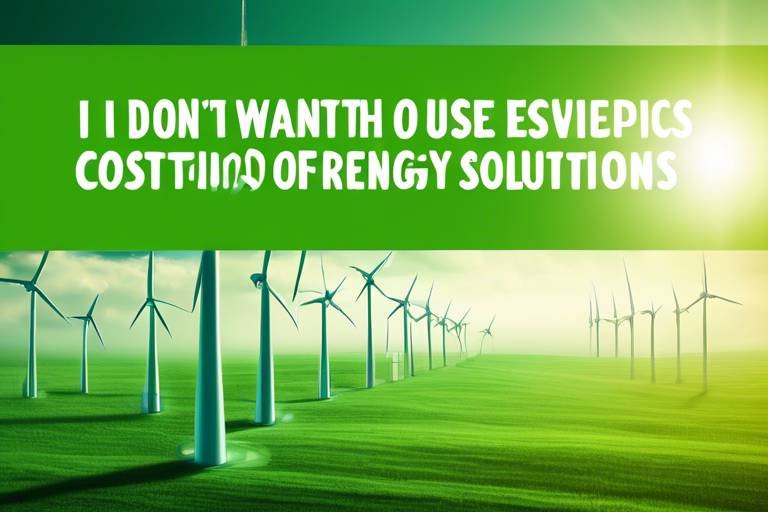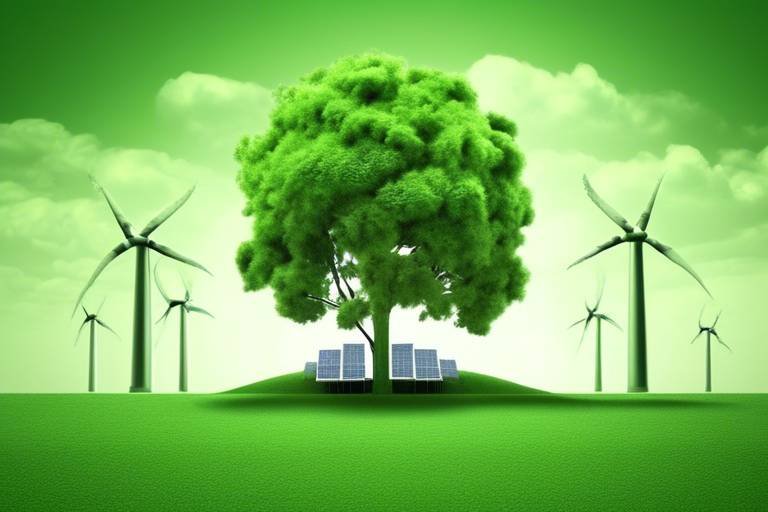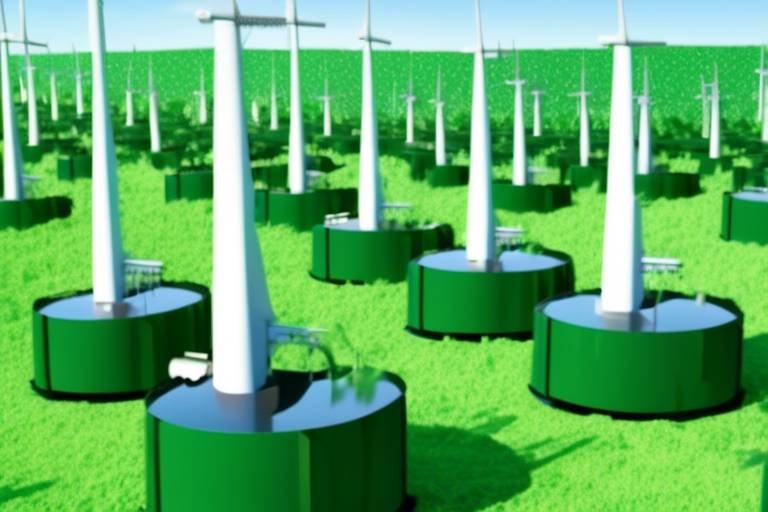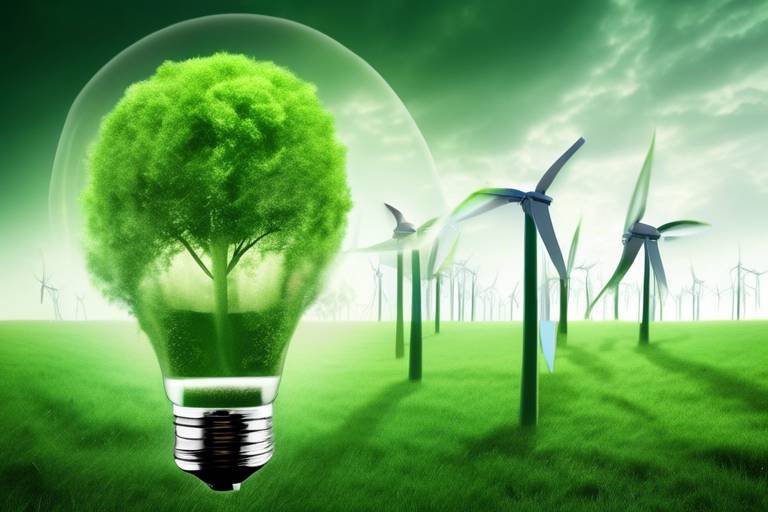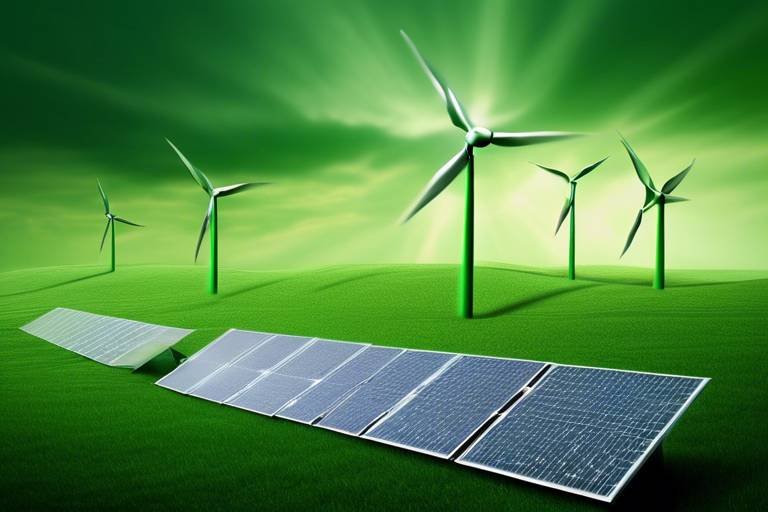The Complex Relationship between Green Energy and Politics
The interplay between green energy initiatives and political frameworks is nothing short of intricate and fascinating. As the world grapples with the pressing challenges of climate change, the urgency to transition to sustainable energy sources has never been more apparent. However, this transition is not merely a technological shift; it is deeply intertwined with political ideologies, public opinion, and international relations. In many ways, the journey toward a greener future resembles a complex dance, where each step taken by governments, corporations, and citizens can either propel us forward or hold us back. So, how do these elements interact, and what does it mean for the future of our planet?
At the heart of this relationship lies the recognition that policies and regulations play a pivotal role in shaping the landscape of renewable energy. Governments worldwide are increasingly recognizing that investing in green technologies is not just a moral imperative but also an economic opportunity. However, the political will to implement such changes often fluctuates based on the prevailing ideologies within a nation. For instance, in countries where conservative values dominate, there may be a reluctance to embrace green energy due to fears of economic disruption. Conversely, liberal governments tend to advocate for more aggressive policies aimed at reducing carbon emissions and promoting sustainable practices.
Moreover, public opinion acts as a powerful force in this equation. Citizens' attitudes towards green energy can significantly influence political decision-making. When the electorate prioritizes environmental issues, politicians are more likely to respond with policies that align with those values. This creates a feedback loop where positive public sentiment can lead to more ambitious green energy initiatives, while negative perceptions can stifle progress. In this context, grassroots movements and media coverage emerge as critical players, shaping narratives and mobilizing support for renewable energy.
As we delve deeper into the nuances of this relationship, it becomes clear that the transition to green energy is a multifaceted challenge that requires collaboration across various sectors and levels of government. The stakes are high, and the path is fraught with obstacles, but the potential rewards—both environmental and economic—are immense. The question remains: can we navigate the complex relationship between politics and green energy to create a sustainable future for generations to come?
- What is the main challenge in transitioning to green energy?
The main challenge lies in the political will and public support needed to implement effective policies and investments in renewable energy sources. - How do political ideologies affect green energy policies?
Different political ideologies prioritize varying aspects of energy policies; conservatives may focus on economic growth while liberals often emphasize environmental protection. - What role does public opinion play in green energy initiatives?
Public perception can significantly influence political agendas, as policymakers are more likely to support initiatives that align with the values of their constituents. - How do international relations impact green energy development?
Global agreements and collaborations, such as the Paris Accord, compel nations to adopt greener policies and technologies, affecting their domestic energy strategies.

Historical Context of Green Energy
This article explores the intricate interplay between green energy initiatives and political frameworks, highlighting how policies, public opinion, and international relations shape the transition to sustainable energy sources.
Understanding the evolution of green energy policies provides crucial insight into the current political dynamics surrounding renewable energy. The journey of green energy began long before the term "renewable" became a buzzword; it has roots that trace back to the early 20th century. The initial push for alternative energy sources was primarily driven by the need to find sustainable solutions to emerging environmental issues, such as air pollution and the depletion of natural resources. Over the decades, various global events have shaped the policies and perceptions surrounding green energy.
For instance, the 1970s oil crisis acted as a wake-up call for many countries, highlighting the vulnerabilities associated with over-reliance on fossil fuels. This crisis led to increased investments in research and development of renewable energy technologies. Countries began to explore options such as solar, wind, and hydroelectric power, laying the groundwork for what would eventually become a global movement toward sustainable energy.
Fast forward to the early 21st century, and we see a significant shift in public awareness regarding climate change. The Kyoto Protocol of 1997 marked a pivotal moment in international climate policy, encouraging nations to commit to reducing greenhouse gas emissions. This agreement not only sparked discussions about climate responsibility but also influenced national policies on green energy. As countries began to recognize the importance of a sustainable future, the political landscape started to evolve, with more governments prioritizing renewable energy initiatives.
Today, the historical context of green energy is reflected in various international agreements, national policies, and local initiatives. It is essential to recognize that these developments are not just isolated events but part of a larger narrative that intertwines politics, economics, and environmental concerns. The table below summarizes key historical milestones in the evolution of green energy:
| Year | Event | Impact |
|---|---|---|
| 1973 | Oil Crisis | Increased focus on alternative energy sources |
| 1997 | Kyoto Protocol | International commitment to reduce emissions |
| 2000s | Growth of Solar and Wind Power | Technological advancements and cost reductions |
| 2015 | Paris Agreement | Global commitment to limit temperature rise |
As we delve deeper into the complexities of green energy and politics, it's essential to consider how these historical events have shaped public perceptions and influenced political ideologies. The interplay of historical context and current events continues to mold the future of energy policies worldwide. What role do you think historical events will play in shaping the future of green energy?
Different political ideologies play a crucial role in shaping green energy policies, with varying levels of support and opposition that impact the implementation of sustainable practices across nations.
Conservative viewpoints often emphasize economic growth and energy independence, which can lead to resistance against green energy initiatives that are perceived as costly or limiting to traditional energy sectors.
Economic arguments against green energy often focus on job losses in fossil fuel industries, raising concerns about the immediate financial implications of transitioning to renewable resources.
The pursuit of energy independence can conflict with green energy initiatives, as some conservatives prioritize domestic fossil fuel production over investment in renewable technologies.
Liberal ideologies generally advocate for aggressive green energy policies, emphasizing environmental protection and the long-term benefits of transitioning to sustainable energy sources for future generations.
Global politics significantly influence green energy development, with international agreements and collaborations shaping national policies and driving the adoption of renewable technologies worldwide.
International climate agreements, such as the Paris Accord, compel nations to commit to reducing carbon emissions, which directly affects their green energy strategies and investments.
Energy security concerns often drive countries to diversify their energy sources, leading to increased investments in green energy as a means of reducing dependence on imported fossil fuels.
Public perception of green energy is a vital factor in political decision-making, influencing policymakers to adopt or reject initiatives based on the electorate's values and priorities.
Grassroots movements advocating for green energy can significantly impact political agendas, mobilizing public support and pressuring governments to prioritize renewable energy initiatives.
Media coverage plays a crucial role in shaping public opinion about green energy, highlighting successes and challenges that can sway political support for sustainable initiatives.
- What is green energy? Green energy refers to energy derived from renewable, zero-emissions sources, such as solar, wind, and hydroelectric power.
- Why is green energy important? Green energy is crucial for reducing greenhouse gas emissions, combating climate change, and promoting sustainable economic growth.
- How do political ideologies affect green energy policies? Different political ideologies can lead to varying levels of support or opposition for green energy initiatives, influencing national strategies and investments.
- What role do international agreements play in green energy development? International agreements, such as the Paris Accord, encourage nations to commit to reducing emissions and investing in renewable energy technologies.

Political Ideologies and Green Energy
The relationship between political ideologies and green energy is as intricate as a spider’s web, with each strand representing a different belief system that influences how societies approach sustainable practices. On one hand, you have conservatives who often prioritize economic growth and energy independence, while on the other hand, liberals advocate for aggressive green energy policies aimed at environmental protection. This ideological divide shapes not only the policies that are enacted but also the public perception of green energy initiatives.
Conservative perspectives on green energy typically emphasize the importance of maintaining a robust economy. Many conservatives view green energy initiatives as potentially costly ventures that could disrupt traditional energy sectors, leading to job losses and economic instability. For instance, the transition to renewable energy sources like wind and solar can be seen as a threat to jobs in the fossil fuel industry, which raises concerns about the immediate financial implications of such a shift.
Moreover, the pursuit of energy independence often complicates the conservative stance on green energy. Many conservatives argue that investing in domestic fossil fuel production is crucial for national security and economic growth. This perspective can lead to resistance against green energy initiatives, as they may be perceived as limiting the country’s ability to harness its own natural resources. In this light, green energy is often viewed as a luxury that can be postponed in favor of more immediate economic concerns.
On the flip side, liberal ideologies generally champion the cause of green energy, emphasizing its long-term benefits for both the environment and society. Liberals argue that transitioning to sustainable energy sources is not just an environmental imperative but also an economic opportunity. They believe that investing in renewable energy technologies can create jobs, stimulate innovation, and ultimately lead to a more resilient economy. This perspective is often backed by the notion that the costs of inaction—such as climate change impacts—far outweigh the initial investments in green technologies.
Furthermore, the liberal approach tends to advocate for policies that support the development of renewable energy infrastructure, such as tax incentives for solar panel installations or funding for research into new energy technologies. This proactive stance reflects a belief that the government has a responsibility to lead the charge toward a sustainable future, making green energy a cornerstone of their political platform.
In summary, the interplay between political ideologies and green energy policies is complex and multifaceted. While conservatives may focus on economic considerations and energy independence, liberals advocate for a more aggressive transition to renewable resources. Understanding these perspectives is crucial for navigating the political landscape surrounding green energy initiatives and for fostering a more sustainable future.
- What is the role of political ideologies in shaping green energy policies?
Political ideologies influence how different groups view and prioritize green energy initiatives, with conservatives often focusing on economic implications and liberals emphasizing environmental benefits. - How do grassroots movements affect green energy policies?
Grassroots movements can mobilize public support and pressure governments to adopt renewable energy initiatives, making them a significant force in political decision-making. - What impact do international agreements have on national green energy strategies?
International agreements compel countries to commit to reducing carbon emissions, directly affecting their green energy policies and investments.

Conservative Perspectives
When it comes to the discussion of green energy, conservative perspectives often bring a unique set of considerations to the table. Many conservatives prioritize **economic growth** and **energy independence**, viewing these as paramount to national interests. This approach can lead to a certain level of skepticism regarding green energy initiatives, particularly when they are perceived as costly or detrimental to traditional energy sectors. The underlying belief is that while sustainability is important, it should not come at the expense of economic stability or job security.
One of the primary arguments against green energy initiatives from a conservative standpoint revolves around **economic considerations**. Critics often highlight that transitioning to renewable energy sources could result in significant job losses within the fossil fuel industry. For many communities, especially those reliant on coal, oil, or gas, the prospect of losing jobs is not just an abstract concern; it’s a matter of survival. The immediate financial implications of such a transition can raise alarms among constituents, leading to resistance against policies that seem to threaten their livelihoods.
Moreover, the pursuit of **energy independence** plays a critical role in shaping conservative views on energy policy. For many conservatives, the goal is to maximize domestic fossil fuel production as a means of reducing reliance on foreign energy sources. This perspective often conflicts with the push for green energy initiatives, which may be seen as undermining national energy security. The argument is made that investing heavily in renewable technologies could divert resources away from developing domestic oil and gas reserves, thus jeopardizing energy independence.
In summary, conservative perspectives on green energy are deeply intertwined with economic and national security considerations. While there is an acknowledgment of the need for cleaner energy sources, the focus tends to lean towards maintaining economic stability and prioritizing energy independence over aggressive green energy policies. This cautious approach reflects a broader concern about the immediate impacts of transitioning away from traditional energy sources, highlighting the complexity of the energy debate in the political landscape.
- What are the main concerns conservatives have about green energy?
Conservatives often worry about job losses in traditional energy sectors and the potential economic impact of transitioning to renewable energy sources. - How do conservative views on energy independence affect green energy policies?
Many conservatives prioritize domestic fossil fuel production to achieve energy independence, which can conflict with investments in green energy technologies. - Are there any conservative advocates for green energy?
Yes, some conservatives advocate for a balanced approach that includes renewable energy as part of a diverse energy portfolio, emphasizing innovation and market-driven solutions.

Economic Considerations
When discussing the transition to green energy, it's impossible to ignore the that play a pivotal role in shaping political perspectives. Many conservatives argue that the shift towards renewable energy sources poses a significant threat to traditional industries, particularly fossil fuels. They often cite potential job losses as a primary concern, fearing that moving away from coal, oil, and gas will lead to unemployment and economic instability in regions heavily reliant on these sectors.
Moreover, the argument about cost frequently surfaces in political debates surrounding green energy. Critics assert that renewable technologies, such as solar and wind, require substantial initial investments, which can strain public budgets and lead to higher taxes. This perspective often leads to a perception that green energy is an expensive luxury that could jeopardize economic growth. However, advocates argue that the long-term savings and environmental benefits ultimately outweigh these initial costs. In fact, a recent study showed that the cost of solar energy has dropped by over 80% in the last decade, making it increasingly competitive with fossil fuels.
Another critical aspect of this economic dialogue is the concept of energy independence. Many conservatives emphasize the importance of relying on domestic energy sources to bolster national security and reduce vulnerability to foreign energy fluctuations. This focus can result in resistance to green energy initiatives, as some policymakers prioritize traditional fossil fuel production over investing in renewable technologies. For them, the idea of energy independence often translates to maintaining a robust fossil fuel industry rather than transitioning to less familiar renewable options.
Despite these concerns, it's essential to recognize the potential for job creation within the green energy sector. The renewable energy industry has been one of the fastest-growing job markets in recent years. According to the Bureau of Labor Statistics, jobs in solar and wind energy are projected to grow significantly faster than the average for all occupations. This shift presents a unique opportunity for workers who may be displaced from fossil fuel jobs to transition into roles in the renewable sector. In fact, many programs are being developed to retrain workers, ensuring they can find employment in this new green economy.
In summary, while economic considerations often fuel resistance to green energy initiatives, it is crucial to look beyond immediate financial implications. The long-term benefits of investing in renewable energy—including job creation, environmental sustainability, and energy security—can ultimately lead to a more resilient economy. As the conversation around green energy evolves, finding a balance between supporting traditional industries and embracing sustainable practices will be key to fostering a comprehensive energy policy that benefits all stakeholders.
- What are the main economic concerns regarding green energy?
Many concerns revolve around job losses in traditional fossil fuel industries and the perceived high costs of transitioning to renewable energy sources. - How can green energy create jobs?
The renewable energy sector is rapidly growing, creating new job opportunities in areas such as solar and wind energy, which often outpace job losses in fossil fuel industries. - What is energy independence, and why does it matter?
Energy independence refers to a nation's ability to meet its energy needs without relying on imported fuels. It is crucial for national security and can influence energy policy decisions. - Are renewable energy sources cost-effective?
Yes, the cost of renewable energy has decreased significantly over the past decade, making it more competitive with traditional fossil fuels.

Energy Independence
The pursuit of is a cornerstone of many conservative political agendas, often leading to a complex relationship with green energy initiatives. At its core, energy independence refers to a nation's ability to meet its energy needs without relying on foreign sources. This goal can sometimes clash with the push for renewable energy, as traditional fossil fuel industries are often viewed as the more immediate solution to achieving energy self-sufficiency. Imagine a country as a ship navigating turbulent waters; the captain (the government) must decide whether to anchor in familiar, fossil-fuel-rich harbors or set sail into the uncharted waters of renewable energy.
Many conservatives argue that investing heavily in green energy technologies could jeopardize the stability of the existing energy sector, potentially leading to job losses and economic downturns. They often highlight the immediate financial implications of transitioning from fossil fuels to renewable resources. For instance, a sudden shift towards solar or wind energy could disrupt the livelihoods of workers in traditional energy sectors, creating a ripple effect that impacts local economies. This concern is not unfounded; the fossil fuel industry employs millions globally, and the fear of job displacement can stymie political will for change.
However, the narrative of energy independence is evolving. As technology advances and the costs associated with renewable energy continue to decline, many are beginning to see the potential for a hybrid approach. This approach allows countries to maintain some level of fossil fuel production while simultaneously investing in green technologies. It's akin to a well-balanced diet; while it's essential to consume some traditional energy sources for immediate needs, integrating renewable options can lead to a healthier, more sustainable future.
Moreover, energy independence is not solely about fossil fuels versus renewables. It also encompasses the diversification of energy sources. Countries that invest in a mix of energy options—such as solar, wind, hydroelectric, and even nuclear—can bolster their energy security. This diversification not only reduces reliance on any single energy source but also mitigates the risks associated with geopolitical tensions that can disrupt fossil fuel supplies. To illustrate this point, consider the table below, which outlines various energy sources and their contributions to energy independence:
| Energy Source | Contribution to Energy Independence |
|---|---|
| Fossil Fuels | Immediate energy supply, job creation, traditional economic stability |
| Solar Energy | Reduces reliance on imports, sustainable long-term solution |
| Wind Energy | Low operational costs, abundant resource in many regions |
| Hydroelectric | Reliable and consistent energy source, potential for local job creation |
| Nuclear Energy | Stable energy output, low carbon emissions, significant initial investment |
In conclusion, while the pursuit of energy independence often emphasizes traditional fossil fuels, the integration of green energy technologies is becoming increasingly vital. The challenge lies in balancing the immediate economic concerns with the long-term benefits of a sustainable energy future. As public opinions shift and technology advances, the political landscape surrounding energy independence will continue to evolve. The question remains: can nations embrace a future where energy independence is achieved through a harmonious blend of traditional and renewable resources?
- What is energy independence? Energy independence refers to a country's ability to meet its energy needs without relying on imports from other nations.
- Why do some politicians oppose green energy initiatives? Many politicians fear that transitioning to green energy could lead to job losses in fossil fuel industries and economic instability.
- Can countries achieve energy independence while investing in green technologies? Yes, a hybrid approach that combines traditional energy sources with renewable technologies can enhance energy independence.
- How does public opinion influence energy policies? Public perception of green energy can sway political decision-making, prompting policymakers to adopt or reject initiatives based on voter priorities.

Liberal Perspectives
When it comes to green energy, liberal ideologies are often at the forefront, advocating for policies that not only emphasize environmental protection but also highlight the long-term benefits of transitioning to sustainable energy sources. Liberals generally view the shift towards green energy as not just a necessity but a moral imperative. They argue that the health of our planet and future generations depends on our actions today. This perspective is rooted in a belief that the environment should not be sacrificed for short-term economic gains. Instead, investing in renewable energy technologies is seen as a way to create a sustainable economy that benefits everyone in the long run.
One of the most compelling arguments made by proponents of liberal green energy policies is the idea that transitioning to renewable sources can lead to job creation. Contrary to the fears often expressed by conservatives about job losses in traditional energy sectors, studies have shown that the green energy sector is rapidly growing. For instance, jobs in solar and wind energy are projected to outpace those in fossil fuels in the coming years. This growth not only contributes to a healthier planet but also stimulates local economies. In fact, many liberal leaders emphasize the potential for green jobs to revitalize communities that have been economically depressed due to the decline of fossil fuel industries.
Moreover, liberals tend to advocate for comprehensive government policies that support renewable energy through subsidies, tax incentives, and research funding. They argue that these measures can help level the playing field against the entrenched interests of fossil fuel companies, which often benefit from substantial government support. By investing in green technologies, liberals believe that governments can drive innovation and make renewable energy more accessible and affordable for everyone. This approach can also lead to a more equitable energy landscape, where all communities have access to clean energy options, regardless of their economic status.
In addition to economic arguments, the liberal perspective often includes a strong emphasis on social justice. Many advocates argue that the impacts of climate change disproportionately affect marginalized communities, making the transition to green energy not just an environmental issue but a social one as well. Liberals often push for policies that ensure these communities are not left behind in the green transition, advocating for investments in clean energy projects in low-income areas and providing job training programs to equip workers for the new green economy.
Ultimately, the liberal perspective on green energy is about embracing change for a sustainable future. It’s about recognizing that the choices we make today will shape the world for generations to come. While there are challenges to overcome, such as political opposition and the need for technological advancements, the liberal ideology remains steadfast in its belief that a green energy revolution is not only possible but essential. By prioritizing environmental policies that align with social equity and economic growth, liberals aim to create a world where clean energy is the norm, not the exception.

International Relations and Green Energy
The relationship between international relations and green energy is a fascinating one, filled with complexities and interdependencies. As nations grapple with the pressing need to combat climate change, their diplomatic interactions increasingly revolve around energy policies and sustainability initiatives. Countries are no longer just competing for resources; they are collaborating on green technology and sharing strategies to transition towards renewable energy sources. This shift is not merely a trend; it's a necessity that shapes global politics.
One of the most significant factors influencing this relationship is the commitment to international climate agreements. Treaties like the Paris Accord bind countries to specific carbon emission reduction targets, which in turn compel them to develop and invest in green energy solutions. For instance, nations that have pledged to reduce their carbon footprints are actively seeking ways to incorporate solar, wind, and hydroelectric power into their energy mix. This commitment not only affects domestic policies but also shapes international alliances, as countries that lead in green technology often find themselves in a position of influence.
Moreover, energy security plays a crucial role in international relations. Countries that rely heavily on imported fossil fuels are increasingly aware of the risks associated with energy dependence. This awareness drives them to diversify their energy sources, leading to a surge in investments in renewable energy. For example, nations in Europe are investing in wind and solar farms to reduce their reliance on oil and gas imports from volatile regions. This strategic pivot not only enhances their energy security but also positions them as leaders in the global green energy landscape.
Furthermore, the dynamics of trade relationships are evolving as countries prioritize green energy technologies. Nations that excel in renewable energy production are likely to become key players in the global market, exporting their technologies and expertise. This shift can lead to new trade agreements that favor sustainable practices. For instance, countries that invest in electric vehicle technology may find themselves in a strong position to negotiate favorable terms with others looking to transition away from fossil fuels.
However, the path to a greener future is fraught with challenges. Political tensions and differing priorities can hinder international cooperation. For instance, nations with strong fossil fuel industries may resist transitioning to renewable energy due to economic concerns, leading to friction in negotiations. Additionally, the disparity in resources and technological capabilities among nations can create an uneven playing field, where wealthier countries advance faster in green energy initiatives, leaving developing nations struggling to keep up.
In conclusion, the interplay between international relations and green energy is marked by both opportunities and challenges. As the world moves towards a more sustainable future, the ability of nations to cooperate and innovate will determine the pace and success of this transition. The stakes are high, and the outcomes will shape not only the energy landscape but also the geopolitical dynamics of the coming decades.
- How do international agreements impact green energy policies?
International agreements like the Paris Accord set binding targets for carbon emissions, compelling nations to adopt green energy solutions to meet their commitments.
- What role does energy security play in the shift to renewable energy?
Energy security drives countries to diversify their energy sources, reducing dependence on imported fossil fuels and promoting investments in renewable technologies.
- How can countries collaborate on green energy initiatives?
Countries can collaborate through technology sharing, joint research projects, and forming trade agreements that prioritize sustainable practices.
- What challenges do nations face in transitioning to green energy?
Challenges include political tensions, economic concerns related to fossil fuel industries, and disparities in resources and technological capabilities among nations.

Climate Agreements
Climate agreements play a pivotal role in shaping the global landscape of green energy. These international accords serve as frameworks that compel nations to commit to reducing their carbon emissions and transitioning towards renewable energy sources. One of the most significant agreements in recent history is the Paris Agreement, which was adopted in 2015. This landmark deal aims to limit global warming to well below 2 degrees Celsius, with an aspirational target of 1.5 degrees. But how do these agreements influence national policies, and what does it mean for the future of green energy?
When countries sign climate agreements, they are not just making promises; they are entering into a pact that often requires them to develop and implement specific strategies to meet their emissions reduction targets. This can include investing in renewable energy technologies, enhancing energy efficiency, and promoting sustainable practices across various sectors. The pressure to comply with these agreements can lead to significant shifts in political priorities, as governments seek to align their national policies with international expectations.
Furthermore, climate agreements can foster collaboration between nations, encouraging the sharing of technology and resources. For instance, countries with advanced renewable energy technologies may work with developing nations to help them leapfrog to cleaner energy solutions. This collaboration not only accelerates the adoption of green technologies but also strengthens international relations, creating a sense of shared responsibility towards combating climate change.
However, the effectiveness of these agreements often hinges on the political will of individual nations. Some countries may sign on to these pacts with enthusiasm, while others might view them as constraints on their economic growth. This disparity can lead to tensions in international relations, as countries grapple with the balance between economic development and environmental responsibility. For example, nations rich in fossil fuels might resist aggressive emissions targets, arguing that such commitments threaten their economic stability and energy security.
To illustrate the impact of climate agreements, let's take a look at the commitments made by various countries under the Paris Agreement:
| Country | Target Year | Commitment |
|---|---|---|
| United States | 2030 | Reduce emissions by 50-52% from 2005 levels |
| European Union | 2030 | At least 55% reduction in greenhouse gas emissions |
| China | 2030 | Peak carbon emissions before 2030 and achieve carbon neutrality by 2060 |
| India | 2030 | Reduce emissions intensity by 33-35% from 2005 levels |
As we can see, these commitments vary greatly, reflecting each country's unique circumstances and priorities. The path to achieving these goals is fraught with challenges, including political opposition, economic considerations, and public opinion. However, the existence of these agreements provides a framework that can guide nations towards a more sustainable future.
In conclusion, climate agreements are more than just diplomatic documents; they are crucial catalysts for change in the global energy landscape. By holding countries accountable and encouraging collaboration, these agreements help to foster a collective effort to combat climate change. The transition to green energy is not merely a policy choice but a necessity for the survival of our planet. As we move forward, the interplay between politics and green energy will continue to evolve, shaped by the commitments made in these agreements and the actions taken by nations worldwide.

Energy Security
Energy security is a multifaceted issue that transcends borders and political ideologies. It refers to the uninterrupted availability of energy sources at an affordable price. In today's interconnected world, energy security is more critical than ever, as nations grapple with the dual challenges of meeting their energy needs and addressing environmental concerns. The shift towards green energy is not just an environmental imperative; it is also a strategic move to bolster energy security. By diversifying energy sources and reducing dependence on imported fossil fuels, countries can enhance their resilience against geopolitical tensions and market fluctuations.
Imagine a nation relying heavily on oil imports from politically unstable regions. This dependence creates vulnerability, as fluctuations in oil prices or disruptions in supply can have dire economic consequences. By investing in renewable energy sources such as solar, wind, and hydropower, countries can mitigate these risks. This transition not only fosters energy independence but also aligns with global efforts to combat climate change. In essence, green energy serves as a shield against energy insecurity, providing a stable and sustainable energy supply.
Moreover, the shift towards renewable energy can lead to job creation and economic growth. As countries invest in new technologies and infrastructure, they open up opportunities for innovation and employment in the green sector. This transition can be likened to planting seeds for a more resilient future—one where energy is not only secure but also sustainable. The benefits of green energy extend beyond environmental protection; they encompass economic stability and national security.
To illustrate the impact of energy security on national policies, consider the following table that highlights key factors influencing energy security through green energy initiatives:
| Factor | Description | Impact on Energy Security |
|---|---|---|
| Renewable Energy Investment | Investment in solar, wind, and other renewables | Reduces dependence on fossil fuel imports |
| Diversification of Energy Sources | Utilizing a mix of energy sources | Enhances resilience to price shocks |
| Technological Innovation | Advancements in energy storage and efficiency | Improves energy reliability and accessibility |
| Policy Frameworks | Government regulations and incentives | Encourages private sector investment in renewables |
In conclusion, energy security is a driving force behind the global transition to green energy. As nations recognize the importance of sustainable practices, they are also acknowledging the strategic advantages that come with energy independence. By prioritizing renewable energy initiatives, countries can not only secure their energy future but also contribute to a healthier planet. The path to energy security is not without its challenges, but the potential rewards—economic growth, environmental sustainability, and geopolitical stability—make it a worthwhile endeavor.
- What is energy security?
Energy security refers to the availability of energy sources in a reliable and affordable manner, ensuring that a nation can meet its energy needs without excessive dependence on external sources. - How does green energy contribute to energy security?
Green energy reduces reliance on imported fossil fuels, diversifies energy sources, and enhances resilience against geopolitical tensions and market fluctuations. - What are the economic benefits of investing in renewable energy?
Investing in renewable energy can lead to job creation, economic growth, and innovation, while also providing a stable energy supply. - Why is energy independence important?
Energy independence minimizes vulnerability to external shocks, such as price fluctuations and supply disruptions, enhancing national security and economic stability.

Public Opinion and Green Energy Policies
The relationship between public opinion and green energy policies is a dynamic and ever-evolving landscape that significantly influences political decision-making. In today's world, where climate change is a pressing issue, the general sentiment towards renewable energy sources can sway policymakers to either embrace or shun sustainable initiatives. It's fascinating to consider how the collective voice of the public can act as a powerful force, shaping the trajectory of green energy development. After all, what do you think drives politicians to advocate for or against certain policies? It often boils down to how they perceive the values and priorities of their constituents.
Grassroots movements have emerged as a vital component in this equation. These movements, often fueled by passionate individuals and organizations, advocate for the adoption of green energy initiatives. They mobilize communities, raise awareness, and create a sense of urgency around the need for sustainable practices. For instance, local campaigns that promote solar energy installations or wind farm developments can generate significant public interest and support. This grassroots pressure can lead to politicians feeling compelled to respond, whether by proposing new legislation or supporting existing green energy policies. It's like a ripple effect; one small action can lead to larger waves of change.
Media influence also plays a crucial role in shaping public opinion about green energy. The way renewable energy topics are covered can either bolster support or create skepticism among the populace. For example, positive stories about successful green energy projects can inspire hope and enthusiasm, while reports highlighting the challenges or failures of such initiatives may breed doubt. The media acts as a lens through which the public views these issues, often framing the narrative around green energy in ways that can either galvanize support or stifle it. In a world saturated with information, the responsibility of the media is immense; they hold the power to inform, misinform, or inspire.
Furthermore, public opinion can be influenced by various factors, including economic conditions, environmental disasters, and global events. For instance, a spike in energy prices may lead individuals to reconsider their stance on renewable energy, viewing it as a viable alternative to traditional fossil fuels. Similarly, catastrophic weather events linked to climate change can awaken a sense of urgency among the public, prompting them to advocate for more robust green energy policies. It's almost as if the universe sends signals that resonate with the collective consciousness, pushing society towards a greener future.
Ultimately, the interplay between public opinion and green energy policies is a complex dance, where each step can lead to significant changes in direction. As we move forward, it's essential for policymakers to remain attuned to the voices of their constituents. After all, in a democratic society, the power truly lies with the people. Engaging the public in discussions about renewable energy, addressing their concerns, and showcasing the benefits of sustainable practices can create a more informed electorate that actively supports green initiatives. It's a collaborative effort; when the public and policymakers align, the potential for transformative change is limitless.
- How does public opinion influence green energy policies? Public opinion can pressure politicians to adopt or reject green energy initiatives based on constituents' values and priorities.
- What role do grassroots movements play in promoting green energy? Grassroots movements mobilize communities and raise awareness, creating urgency around sustainable practices and influencing political agendas.
- How does media coverage affect public perception of green energy? Media coverage can shape narratives, influencing public sentiment either positively or negatively regarding green energy initiatives.
- Can economic conditions impact public support for renewable energy? Yes, economic factors like energy prices and job availability can shift public opinion towards or against green energy solutions.

Grassroots Movements
Grassroots movements have become a powerful force in shaping green energy policies and initiatives across the globe. These movements often originate from local communities, driven by individuals who are passionate about environmental issues and the need for sustainable practices. They act as the voice of the people, advocating for change at local, national, and even international levels. The rise of social media and digital communication has further amplified their reach, allowing them to mobilize support quickly and effectively. But what exactly do these movements entail, and how do they influence political landscapes?
At their core, grassroots movements are about community engagement and empowerment. They unite individuals around a common goal—often the transition to renewable energy sources. These movements can take many forms, from local protests and petitions to organized campaigns and educational programs. For instance, local groups may rally to oppose a fossil fuel project or advocate for solar energy installations in their neighborhoods. By doing so, they not only raise awareness but also pressure local governments to adopt more sustainable policies.
One of the most remarkable aspects of grassroots movements is their ability to create a sense of urgency and mobilize public sentiment. When communities come together to advocate for green energy, they often highlight the immediate benefits, such as job creation, health improvements, and economic resilience. This collective action can lead to significant political change. For example, in many cases, elected officials have had to respond to the demands of their constituents, leading to the implementation of more progressive energy policies.
Moreover, grassroots movements often rely on a variety of strategies to influence public opinion and policy. These can include:
- Awareness Campaigns: Utilizing social media platforms to spread information about the benefits of green energy.
- Community Events: Organizing workshops, town hall meetings, and festivals to educate the public and foster community involvement.
- Partnerships: Collaborating with local businesses, schools, and environmental organizations to amplify their message.
These strategies not only raise awareness but also build a network of supporters who are committed to the cause. As these movements gain momentum, they can significantly influence the political agenda, often leading to the introduction of new legislation aimed at promoting renewable energy.
Furthermore, grassroots movements can serve as a counterbalance to corporate interests that may prioritize profit over environmental sustainability. By advocating for transparency and accountability, these movements ensure that the voices of ordinary citizens are heard in the decision-making processes that affect their lives and the planet. They remind policymakers that the transition to green energy is not just a technical challenge but a moral imperative that resonates with the values of the community.
In conclusion, grassroots movements play a pivotal role in the green energy landscape. They empower individuals, raise awareness, and create a collective demand for sustainable practices. As these movements continue to grow and evolve, they will undoubtedly remain a critical component in the fight for a cleaner, greener future. The interplay between grassroots activism and political action is a dynamic one, and it’s clear that when communities unite, their impact can be profound.
- What are grassroots movements? Grassroots movements are community-driven initiatives aimed at advocating for change, often focusing on social, environmental, or political issues.
- How do grassroots movements influence green energy policies? By mobilizing public support and raising awareness, grassroots movements can pressure policymakers to adopt more sustainable practices and legislation.
- Can grassroots movements work with larger organizations? Yes! Many grassroots movements partner with NGOs, businesses, and other organizations to amplify their message and achieve common goals.
- What role does social media play in grassroots movements? Social media platforms allow grassroots movements to reach a wider audience, engage supporters, and organize events quickly and effectively.

Media Influence
The media plays a pivotal role in shaping public opinion about green energy, acting as both a mirror and a magnifying glass for societal attitudes towards sustainability. With the rise of digital platforms and social media, information spreads faster than ever, making it crucial for news outlets to report accurately on green energy initiatives. But how does the media influence public perception? Well, it can highlight the successes of renewable energy projects, showcasing innovative technologies and their benefits, or it can emphasize the challenges and setbacks, which can lead to skepticism among the public.
For instance, when the media covers stories about solar farms reducing electricity bills or wind energy creating jobs, it paints a positive picture that can sway public opinion in favor of green initiatives. On the flip side, if reports focus on the high costs of transitioning to renewable resources or the intermittent nature of wind and solar power, it can foster doubt and resistance. This duality in media coverage can create a rollercoaster effect on public sentiment, making it essential for journalists to strike a balance in their reporting.
Moreover, the media's portrayal of environmental crises, such as climate change, can serve as a wake-up call, prompting discussions about the urgent need for sustainable practices. Documentaries, news features, and social media campaigns can ignite grassroots movements and galvanize public support for green energy policies. When people see compelling visuals of melting ice caps or devastating wildfires, it can evoke emotional responses that translate into political action.
In addition, the rise of influencers and environmental activists on platforms like Instagram and TikTok has changed the landscape of how green energy is perceived. These figures can reach younger audiences, educating them about the importance of sustainability and encouraging them to advocate for change. The ability of social media to mobilize and inform has never been more powerful, allowing for a grassroots approach to environmental advocacy that traditional media outlets may struggle to achieve.
To illustrate the impact of media on public perception, consider the following table that summarizes key influences:
| Media Type | Impact on Public Perception |
|---|---|
| News Articles | Can inform and educate, but may also create skepticism depending on the framing. |
| Documentaries | Often evoke emotional responses and raise awareness about environmental issues. |
| Social Media Campaigns | Engage younger audiences and can drive grassroots movements effectively. |
| Influencer Content | Personal stories and relatable content can humanize green energy issues. |
In conclusion, the media's influence on green energy policies cannot be understated. As it continues to evolve, the responsibility of journalists and content creators to provide balanced, accurate, and engaging information becomes increasingly important. By doing so, they can foster a more informed public that is empowered to advocate for sustainable energy solutions.
- How does the media influence public opinion on green energy? The media can shape perceptions through its coverage, highlighting successes and challenges, which can either bolster support or foster skepticism.
- What role do social media platforms play in promoting green energy? Social media platforms allow for rapid information dissemination and engagement, enabling grassroots movements to gain traction and influence public discourse.
- Can documentaries impact policy decisions regarding green energy? Yes, documentaries that raise awareness about environmental issues can mobilize public support, which in turn can influence policymakers to prioritize green energy initiatives.
Frequently Asked Questions
- What is the relationship between green energy and politics?
The relationship between green energy and politics is complex and multifaceted. Political frameworks, public opinion, and international relations all play significant roles in shaping how green energy initiatives are developed and implemented. Policies can either promote or hinder the transition to sustainable energy sources, depending on the prevailing political ideologies and public sentiments.
- How have historical events influenced current green energy policies?
Historical events have a profound impact on current green energy policies. Past decisions, such as the development of fossil fuel industries and previous environmental regulations, shape today's strategies and public perceptions regarding renewable energy. Understanding this historical context is essential to grasp the ongoing political dynamics surrounding green energy.
- What role do political ideologies play in shaping green energy initiatives?
Political ideologies significantly influence the support or opposition to green energy initiatives. Conservatives may prioritize economic growth and energy independence, often leading to resistance against renewable energy investments. In contrast, liberals typically advocate for aggressive green energy policies, emphasizing the importance of environmental protection and sustainable practices for future generations.
- How do international relations affect green energy development?
International relations play a crucial role in green energy development through climate agreements and global collaborations. Agreements like the Paris Accord compel nations to commit to reducing carbon emissions, which directly influences their green energy strategies. Additionally, energy security concerns often drive countries to diversify their energy sources, leading to increased investments in renewable technologies.
- Why is public opinion important in green energy policies?
Public opinion is vital in shaping green energy policies because it influences political decision-making. Policymakers often align their initiatives with the values and priorities of their constituents. Grassroots movements advocating for green energy can mobilize public support and pressure governments to prioritize renewable initiatives, while media coverage can sway public perceptions and political backing for sustainable practices.
- What impact do grassroots movements have on green energy initiatives?
Grassroots movements can have a significant impact on green energy initiatives by mobilizing public support and influencing political agendas. These movements raise awareness about the importance of renewable energy and can pressure governments to adopt more aggressive policies. Their collective voice often drives change and encourages policymakers to prioritize sustainability in their agendas.
- How does media coverage influence public perception of green energy?
Media coverage plays a crucial role in shaping public perception of green energy. By highlighting successes and challenges in the renewable energy sector, media outlets can sway public opinion and, consequently, political support for green initiatives. Positive stories about green energy advancements can foster optimism and encourage policymakers to invest in sustainable practices.




